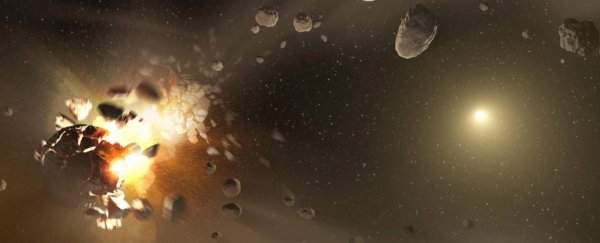Around 467 million years ago, something strange happened to our planet. The trilobites, brachiopods, and conodonts that thrived in Earth's oceans started to disappear, replaced by an explosion of invertebrate marine life closer to what we see in our oceans today.
This is known as the Ordovician radiation, and to date, it's the largest known biodiversity increase in Earth's history. Based on the geological and fossil record, scientists have pieced together that it was triggered by a cooling climate as Earth settled into an ice age.
But what triggered the cooling? That's been a matter of debate, but according to new research, we can rule out one potential and perhaps somewhat controversial explanation: space dust.
This dust, according to a 2019 paper, was generated by a collision between two asteroids in the asteroid belt between Mars and Jupiter. The subsequent dust spreading through the Solar System, that paper concluded, could have prevented enough sunlight from reaching Earth to trigger a cooling event.
In a new paper, geologist Jan Audun Rasmussen of Museum Mors in Denmark and colleagues conclude there's just one problem: The start of the Ordovician radiation predates the asteroid collision.
"Our results demonstrate that the period of colder weather and increased biodiversity occurred long before the asteroid explosion and subsequent meteor bombardment – 600,000 years earlier, to be precise," said geologist and paleontologist Nicolas Thibault of the University of Copenhagen in Denmark.
"This proves that these two phenomena cannot be linked."
To get to the bottom of this question, the research team turned to the bottom of the ocean. They made a careful study of fossils from the sedimentary seabed at Steinsodden in Norway, preserved in limestone layers, looking to track and date changes in biodiversity in Earth's ocean during the Ordovician period.
This allowed them to piece together the chain of events of the Ordovician radiation.
"Our study shows that a shift towards a colder climate began exactly 469.2 million years ago," said paleontologist Christian Mac Ørum Rasmussen of the University of Copenhagen. "Two hundred thousand years later, temperatures were even lower and caused ice to form at the then South Pole."
In fact, the layers reveal that the shift in climate towards cooler temperatures coincided with a change in Earth's orbital eccentricity and axial tilt with respect to the Sun. This is a known phenomenon, and it happens regularly. Each shift takes place over tens of thousands of years, creating glacial and interglacial climate cycles called Milankovitch cycles. (No, these cycles have nothing to do with the current rate of climate change.)
That's not to say that asteroid dust didn't have an effect here on Earth. It was a big kaboom, and its effects are still ongoing today; chunks of it make up around a third of all meteorites falling to Earth today. It's just that the effect was sort of the opposite of what the original paper found, the researchers said.
"Instead of triggering an increase in biodiversity, the cosmic dust from the asteroid's explosion probably acted as a temporary brake on species evolution," Jan Audun Rasmussen said. "The dust blocked sunlight, which impaired most photosynthetic processes – and the living conditions of animals in general, as a result."
More work can help resolve the role of glaciation and Milankovitch cycles in the Ordovician radiation, but ruling out cosmic dust is an important step forward, the researchers said.
"Our study has brought us a step closer to understanding what led to this large increase in biodiversity," Thibault said.
"At the same time, we have also discovered an important piece of the puzzle with regards to how climate affects biodiversity and life on Earth in general. This knowledge will allow us to better prevent the loss of animal and plant diversity in the future."
The research has been published in Nature Communications.
